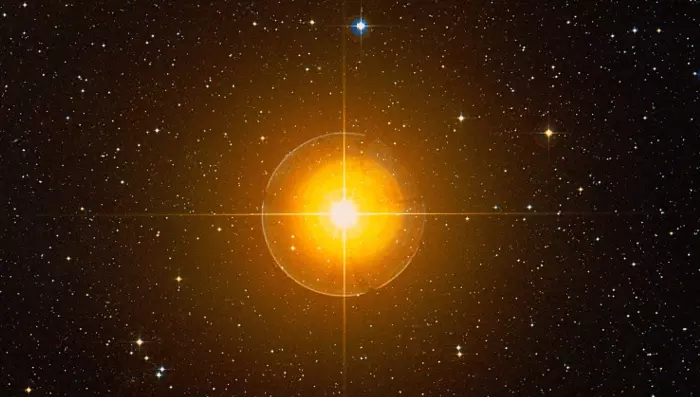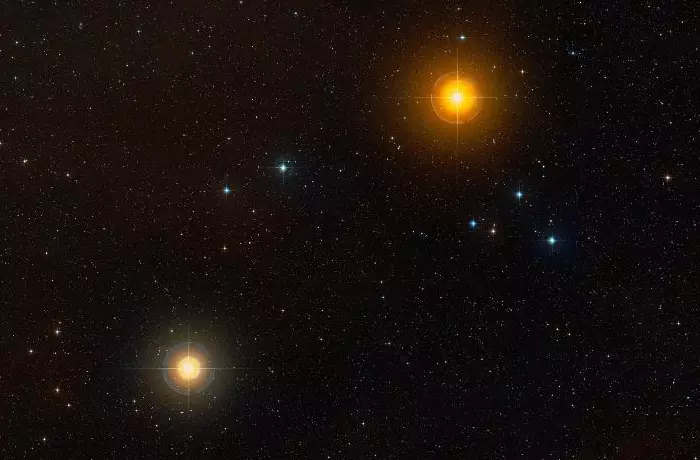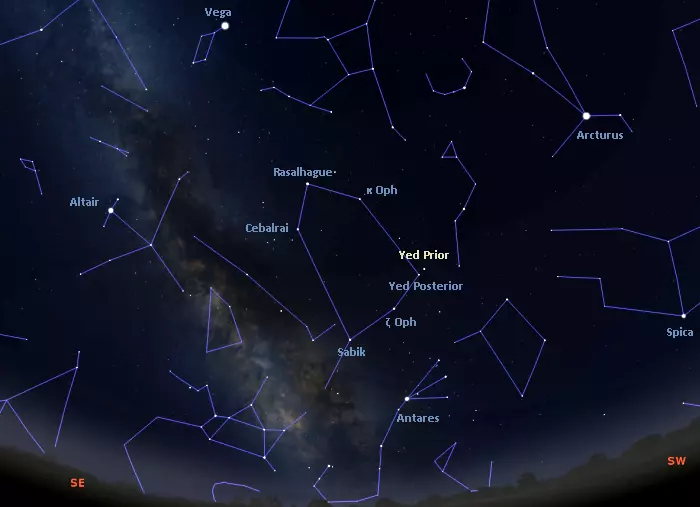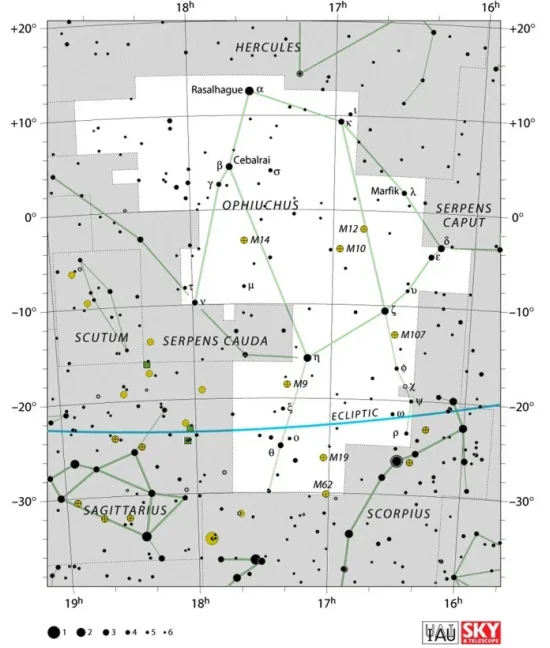Yed Prior, Delta Ophiuchi (δ Oph), is a red giant star located 171 light-years away in the constellation Ophiuchus. With an apparent magnitude of 2.75, it is the fourth brightest star in Ophiuchus, after Rasalhague, Sabik, and Zeta Ophiuchi. Together with the nearby Yed Posterior (Epsilon Ophiuchi), it marks the left hand of the celestial Serpent Bearer.
Star type
Yed Prior is a red giant of the spectral type M0.5 III. It has a mass of 1.5 solar masses and a radius 59 times that of the Sun. With a surface temperature of 3,679 K, it is around 630 times more luminous than the Sun.
The star is currently on the asymptotic giant branch (AGB). It has a mostly inert core of carbon and oxygen, a shell where helium is being fused to carbon, and another shell where hydrogen is being fused into helium.
Delta Ophiuchi is catalogued as a suspected variable. Its brightness has been reported to vary by 0.03 magnitudes.

Yed Prior (Delta Ophiuchi), image: Wikisky
Facts
In Arabic astronomy, Yed Prior was part of an asterism called the Southern Line or the Southern Boundary (al-Nasaq al-Yamānī), along with Unukalhai (Alpha Serpentis), Delta Serpentis, Epsilon Serpentis, Yed Posterior (Epsilon Ophiuchi), Zeta Ophiuchi, and Sabik (Eta Ophiuchi). The Northern Line was formed by Kornephoros (Beta Herculis) and Gamma Herculis with Beta and Gamma Serpentis. The stars in the area between the two lines represented a pasture with sheep guarded by a shepherd, represented by Rasalhague (Alpha Ophiuchi).
Name
The name Yed Prior (pronunciation: /ˌjɛd ˈpraɪər/) comes from the Arabic yad, meaning “hand.” It refers to the star’s position at the left hand of Ophiuchus. In depictions of the constellation, this is the hand of the celestial Serpent Bearer that holds the head of the serpent. The word “prior” (Latin for “in front of” or “former”) refers to the fact that the star leads Yed Posterior (Epsilon Ophiuchi) across the sky. It is the western of the two stars marking the hand of Ophiuchus. Even though they appear close in the sky – about one degree apart – Yed Prior and Yed Posterior are not physically related.

Yed Prior and Yed Posterior (Delta Ophiuchi and Epsilon Ophiuchi), image: Wikisky
The name Yed Prior was approved by the International Astronomical Union’s (IAU) Working Group on Star Names (WGSN) on October 5, 2016.
In Chinese astronomy, Delta Ophiuchi was known as 天市右垣九 (Tiān Shì Yòu Yuán jiǔ), the Ninth Star of Right Wall of Heavenly Market Enclosure. It was part of the asterism called Right Wall of Heavenly Market Enclosure along with Kornephoros (Beta Herculis), Gamma Herculis, Marsic (Kappa Herculis), Gamma Serpentis, Beta Serpentis, Unukalhai (Alpha Serpentis), Delta Serpentis, Epsilon Serpentis, Yed Posterior (Epsilon Ophiuchi), and Zeta Ophiuchi. The asterism was part of the Heavenly Market Enclosure, which represented the emperor’s realm. Yed Prior represented the state of Liang.
Location
Yed Prior is easy to identify because it is part of the large polygon that dominates the constellation Ophiuchus. The polygon figure is formed by the constellation’s brightest stars, Rasalhague, Sabik, Zeta Ophiuchi, Yed Prior, Cebalrai, and Kappa Ophiuchi. Yed Prior marks the southwestern corner of the polygon. It appears just north of the claws of the Scorpion and right of the fainter Yed Posterior.

The location of Yed Prior, image: Stellarium
Rasalhague, the brightest star in Ophiuchus, appears halfway between Vega and Antares, and the base of the polygon can be found using the stars of the Teapot in Sagittarius. The base is roughly aligned with the imaginary line extended from Kaus Australis through Alnasl, the westernmost stars of the Teapot. In the opposite direction, a line extended through the base of the polygon leads to Unukalhai, the brightest star in Serpens. Unukalhai is the brightest star in the region between Yed Prior and Arcturus in the constellation Boötes.
Constellation
Yed Prior is located in the constellation Ophiuchus. The celestial Serpent Bearer is the 11th largest constellation in the sky, occupying an area of 948 square degrees of the predominantly southern sky. The constellation lies on the celestial equator and is visible from any inhabited location on Earth for at least part of the year.
Ophiuchus is one of the 48 Greek constellations, listed by the Greco-Roman astronomer Claudius Ptolemy of Alexandria in his Almagest in the 2nd century CE. In Greek mythology, it is associated with the healer Asclepius and with the god Apollo.
With five stars brighter than magnitude 3.0, Ophiuchus is easily visible even from areas with some light-pollution. It does not contain any first-magnitude stars, but it is recognizable nonetheless because its brightest stars form a large polygon just above the brighter Scorpius. Rasalhague, the constellation’s lucida, is a white giant with an apparent magnitude 2.07, located 48.6 light-years away.

Ophiuchus constellation map by IAU and Sky&Telescope magazine
Other notable stars in the constellation include Barnard’s Star, the fourth individual nearest star to the Sun (after the three stars in the Alpha Centauri system), Zeta Ophiuchi, the nearest O-type star to Earth, the nearby red dwarf Wolf 1061, the binary star Sabik (Eta Ophiuchi), the recurrent nova RS Ophiuchi, and the star system Rho Ophiuchi, surrounded by one of the closest star-forming regions to the Sun, the Rho Ophiuchi cloud complex.
The best-known deep sky objects in Ophiuchus are Kepler’s Supernova, the Rho Ophiuchi molecular cloud, the bipolar planetary nebula nicknamed the Twin Jet Nebula (M2-9), the ultraluminous infrared galaxy NGC 6240 (the Starfish Galaxy), the Dark Horse Nebula, and the bright open clusters NGC 6633 (the Tweedledum Cluster) and IC 4665 (the Hi Cluster). The constellation is also home to seven bright globular clusters listed in the Messier catalogue: M9, M10, M12, M14, M19, M62, and M107.
The best time of the year to observe the stars and deep sky objects in Ophiuchus is during the month of July, when the constellation is high above the horizon in the evening. The entire constellation is visible from locations between the latitudes 80° N and 80° S.
The 10 brightest stars in Ophiuchus are Rasalhague (Alpha Oph, mag. 2.07), Sabik (Eta Oph, mag. 2.43), Zeta Ophiuchi (mag. 2.569), Yed Prior (Delta Oph, mag. 2.75), Cebalrai (Beta Oph, mag. 2.75), Kappa Ophiuchi (mag. 3.20), Yed Posterior (Epsilon Ophiuchi, mag. 3.22), Theta Ophiuchi (mag. 3.26), Nu Ophiuchi (mag. 3.332), and 72 Ophiuchi (mag. 3.73).
Yed Prior – Delta Ophiuchi
| Spectral class | M0.5 III |
| Variable type | Suspected |
| U-B colour index | +1.96 |
| B-V colour index | +1.59 |
| Apparent magnitude | 2.75 |
| Absolute magnitude | -0.90 |
| Distance | 171 ± 1 light-years (52.5 ± 0.4 parsecs) |
| Parallax | 19.06 ± 0.16 mas |
| Radial velocity | -18.784100 ± 0.002391 km/s |
| Proper motion | RA: -47.54 mas/yr |
| Dec.: -142,73 mas/yr | |
| Mass | 1.5 M☉ |
| Luminosity | ~ 630 L☉ |
| Radius | 59 R☉ |
| Temperature | 3,679 K |
| Metallicity | 0.32 dex |
| Rotational velocity | 7.0 km/s |
| Surface gravity | 1.4 cgs |
| Constellation | Ophiuchus |
| Right ascension | 16h 14m 20.73853s |
| Declination | –03° 41′ 39.5612″ |
| Names and designations | Yed Prior, Delta Ophiuchi, δ Oph, 1 Ophiuchi, HD 146051, HR 6056, HIP 79593, SAO 141052, BD-03 3903, FK5 603, GC 21838, GCRV 9340, JP11 2719, NSV 7556, PLX 3684.00, PPM 199443, IRAS 16117-0334, 2MASS J16142073-0341393, UBV 13793, WEB 13466, TD1 18991, TYC 5037-1068-1, Gaia DR2 4357027756656094208, Gaia DR3 4357027756659697664, CCDM J16143-0342A, IDS 16091-0326 A, WDS J16143-0342A |